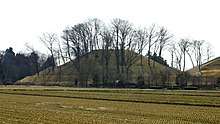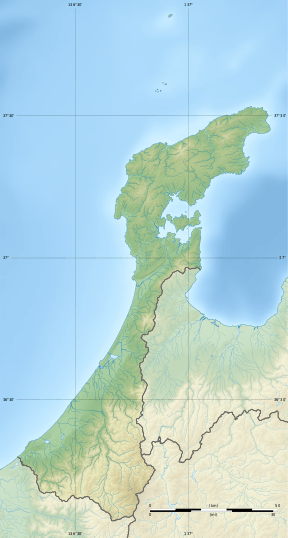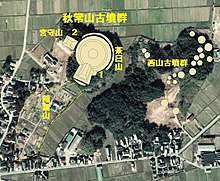Akitsuneyama Kofun Cluster
Akitsuneyama Kofun Group (秋常山古墳群, Akitsuneyama kofun-gun) is a group of Kofun period burial tumulus located in Terai, Ishikawa (now part of Nomi, Ishikawa) in the Hokuriku region of Japan. The site is an archaeological park and was designated a National Historic Site of Japan in 1975 collectively with 26 other kofun located in the vicinity of Nomi.[1]
秋常山古墳群 | |
 | |
 Akitsuneyama Kofun Group  Akitsuneyama Kofun Cluster (Japan) | |
| Location | Nomi, Ishikawa, Japan |
|---|---|
| Region | Hokuriku region |
| Coordinates | 36°26′59″N 136°31′08″E |
| Type | Kofun |
| History | |
| Founded | Kofun period |
| Site notes | |
| Ownership | National Historic Site |
| Public access | Yes |

Overview
The site consists of two kofun. Kofun No.1 is a keyhole-shaped tumuli, and was built at the end of the early Kofun period in the 4th century AD. It has a length of 141 meters, making it the largest ancient tomb in the Hokuriku region. Kofun No.2 is a square tumuli, and dates from the middle of the middle Kofun period. The site is located on a slight elevation above the plain of the Tedori River, within view of the Sea of Japan. The site was severely damaged locals, who pillaging the ancient tombs for iron artifacts, which were given to the authorities to be melted down as part of the war effort, and up to ten smaller kofun in the vicinity were completely destroyed.
However, Kofun No.1 was spared, as, despite its huge size, it was not discovered until 1984. It was located within the grounds of the Aritsune Hachiman Shrine, and was considered a natural hill covered by a dense growth of trees. When the trees were cleared away, the kofun was found to have a three-trier structure. The bottom trier had a length of 141 meters, with a 108 meter circular portion, 67 meter wide rectangular portion and a height of 19 meters. The middle trier had a length of 121.5 meters, with a 90.5 meter circular portion, 46.5 meter wide rectangular portion and a height of 16 meters. The third trier was on the circular portion only, extending its height by 4 meters. In addition, there was a protrusion on the east side of the kofun, measuring 8 by 16 meters extending out from the second trier. The entire kofun was covered with fukiishi
The interior of the kofun has not been excavated, but the presence of a burial chamber was confirmed by ground penetrating radar, with a wooden sarcophagus exceeding 8 meters in length, with the presence of metallic grave goods. However, radar also indicated the possibly of a second burial chamber located in the vicinity of the anterior part mound top and neck.
Kofun No.2 was excavated in 2001. It had dimensions of 32.5 meters by 27 meters, with a maximum height of 5.4 meters. Much of it had been destroyed by farmers for dirt. Numerous haniwa and grave goods were excavated, including beads and fragments of swords and other metal objects.
References
- "能美古墳群" (in Japanese). Agency for Cultural Affairs.
External links
![]()
- Ishikawa Prefectural information home page (in Japanese)